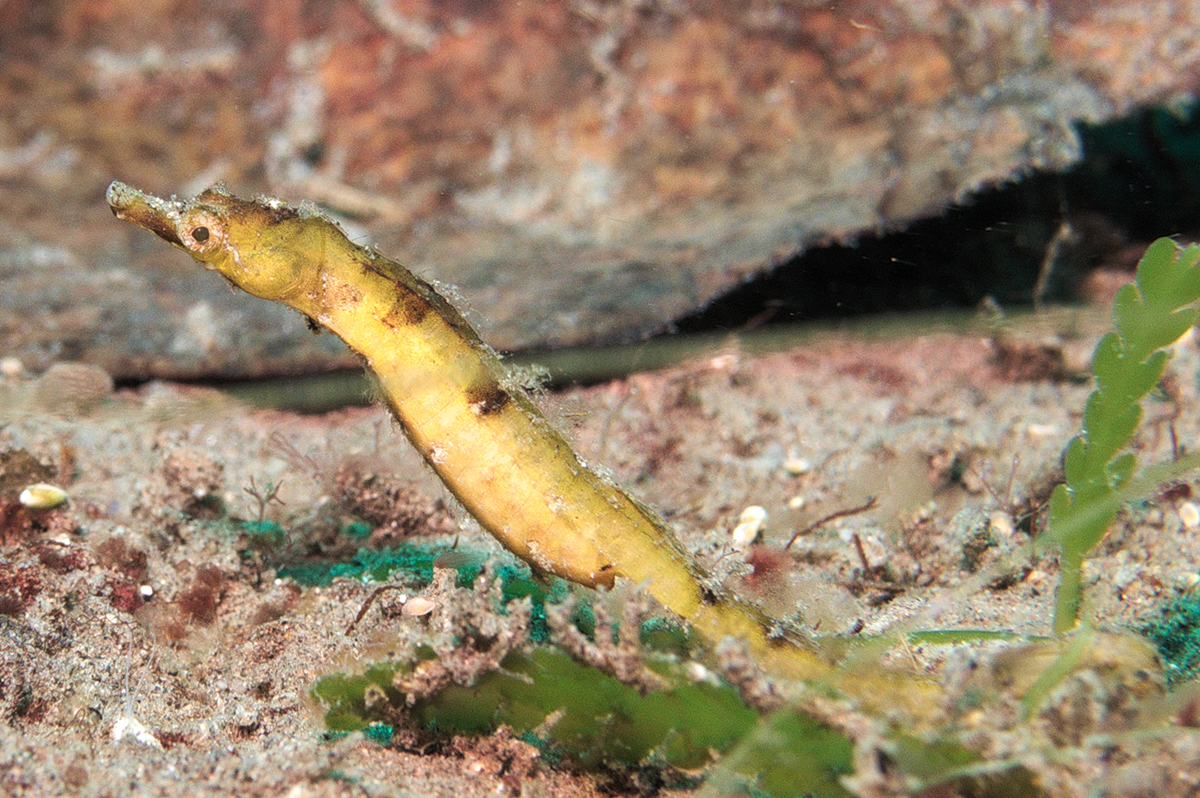Shortpouch Pygmy Pipehorse, Acentronura breviperula Fraser-Brunner & Whitley 1949

A Shortpouch Pygmy Pipehorse, Acentronura breviperula, at Dauin, Negros Island, Philippines, March 2018. Source: Klaus Stiefel / Flickr. License: CC By Attribution-NonCommercial
This small, drab-coloured pipehorse is very well camouflaged in sandy and silty environments. Although it has a prehensile tail like a seahorse, the Shortpouch Pygmy Pipehorse lacks an angled head and swims horizontally.
Shortpouch Pygmy Pipehorse, Acentronura breviperula Fraser-Brunner & Whitley 1949
More Info
|
Distribution |
Torres Strait, northern Great Barrier Reef, Australia. Elsewhere the species occurs in the Indo-West Pacific: East Africa, Madagascar, the Red Sea, Persian Gulf, Papua New Guinea, New Caledonia, and Taiwan. Inhabits shallow protected coastal reefs, usually in sandy or silty areas among sparse seagrass beds and algal-covered rocks. |
|
Features |
Dorsal fin 14-16; Pectoral fin 14-16; Total rings 51-56; Trunk rings 12; Tail rings 39-44. The head is in line with body rather than being bent at an angle like a seahorse. The frontal and orbital ridges are somewhat elevated. The trunk is deep and the tail prehensile like a seahorse. Caudal fin absent. |
|
Size |
To 6.3 cm |
|
Colour |
Variable in coloration and often a mottled dark greenish brown with blackish dermal flaps. |
|
Feeding |
Feeds on small invertebrates. |
|
Biology |
The sexes are separate, and individuals are usually seen in pairs, and may form a monogamous relationship. Males brood the developing eggs in an enclosed pouch on the underside of the body. |
|
Fisheries |
Of no interest to fisheries. |
|
Conservation |
Australian Government EPBC Act 1999: Acentronura tentaculata is a listed Marine species under the Environment Protection and Biodiversity Conservation Act 1999 (EPBC Act 1999 Marine Species). |
|
Remarks |
The Shortpouch Pygmy Pipehorse was previously called Acentronura tentaculata in Australia, however, A. tentaculata is endemic to the Red Sea, and A. breviperula is the correct name for the Australian species (Kuiter, 2000). |
|
Similar Species |
Differs from other species in the genus in having the following combination of characters: supraoccipital consisting of a distinct bony bipartite dorsomedial crest, segments arcuate in lateral view, followed by an elevated and long bony dimple; posterior margin of second segment of dorsomedial crest merging within the bony dimple, which is approximately one-third longer than the dorsomedial crest and tapered posteriorly. |
|
Etymology |
Acentronura is from the Greek a (without), kentron (sting) and oura (tail). The specific name tentaculata is from the Latin tentaculum (feeler, holdfast) in reference to the long dermal tentacles. |
|
Species Citation |
Acentronura breviperula Fraser-Brunner & Whitley 1949, Rec. Aust. Mus. 22(2) :148, Fig. 1. Type locality: Mabuiag, Torres Strait, Queensland, Australia. |
|
Author |
Dianne J. Bray & Vanessa J. Thompson |
Shortpouch Pygmy Pipehorse, Acentronura breviperula Fraser-Brunner & Whitley 1949
References
Bathurst : Crawford House Press 557 pp. figs [499] (as A. tentaculata)








